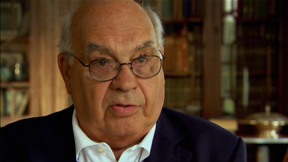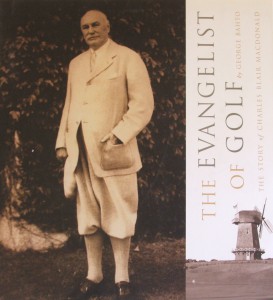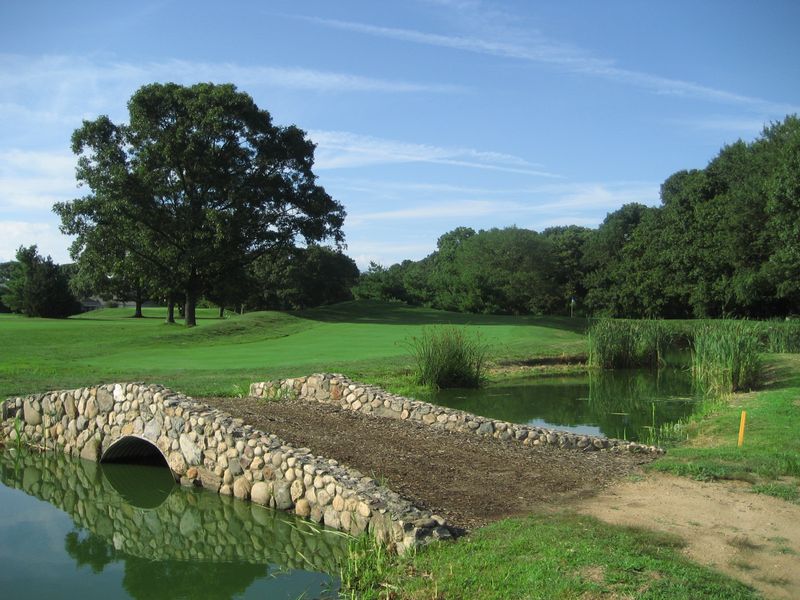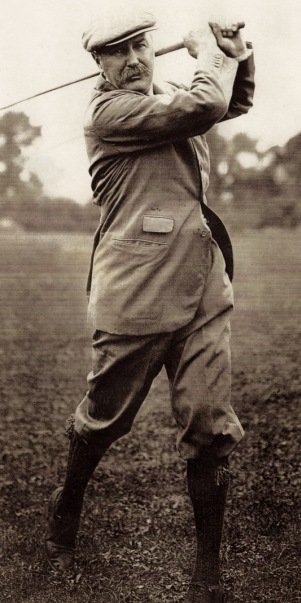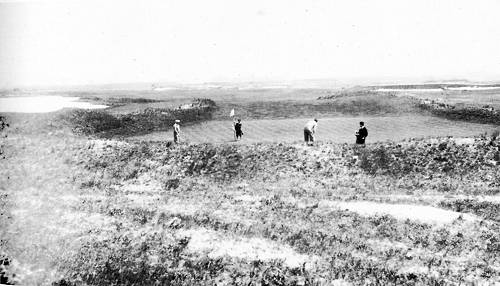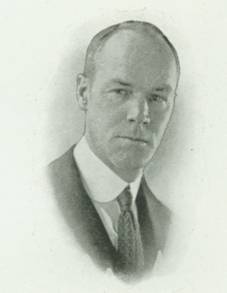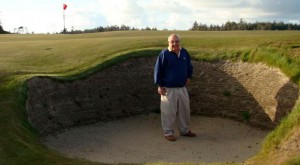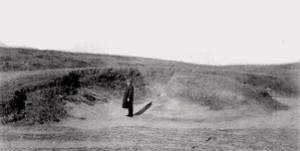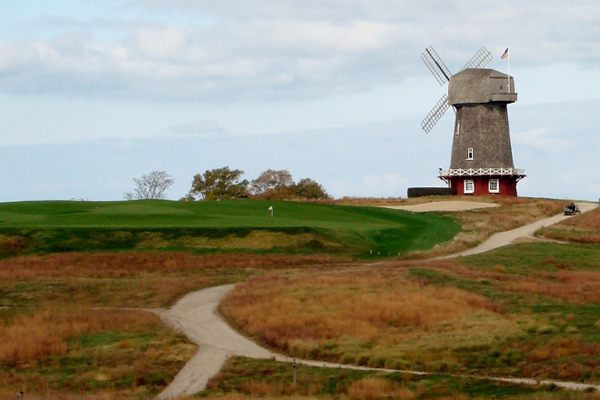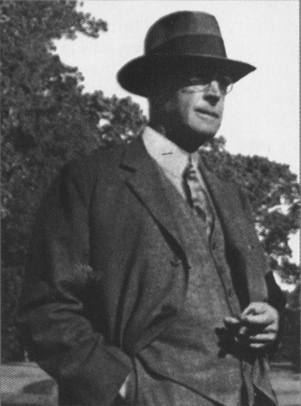George Bahto died on March 18, 2014 at the age of 83. I was lucky enough to meet George and tour his Seth Raynor tribute course, Stonebridge, for a piece that appeared in New York Golf magazine in 2002 as “Reviving Raynor.” It’s presented here in somewhat edited form by way of tribute. But yes, Bahto’s The Evangelist of Golf most certainly came out and further cemented his credentials. He went on to do more course work, best updated here in Bradley Klein’s piece in Golfweek, though as Klein notes, the Raynor book remains unfinished. And for those who must know, Raynor’s middle name was Jagger.
***
In Joseph Mitchell’s classic Joe Gould’s Secret, the secret turns out to be that Joe’s long-awaited masterpiece, An Oral History of Our Time, is an unwritten phantom, a gargantuan manuscript eleven times longer than the Bible only in Joe’s mind, a concoction of thin air.
By now we should know whether George Bahto’s The Evangelist of Golf is a similar phantasm. The book, about Charles Blair Macdonald and his golf architecture disciples Seth J. Raynor and Charles Banks, has been a publishing rumor about as long as Jimmy Hoffa has been missing. But last summer Bahto said the book should finally be heading to the publisher in the fall, and out by the following spring, meaning now. If so, the book will also clear up another pernicious mystery–what the “J” stands for in Seth J. Raynor.
“Yes, I know,” said Bahto at the time, “but I’m not telling, yet.” Bahto was in a playful mood anyway, deflecting potential accusations of ignoring deadlines with a rhetorical question: “Say you’re writing a book, and have a chance that it will be well-received and you’ll become a little well-known. Or you have a chance to build a golf course like this? Which way are you going to go?”
The question was rhetorical because Bahto was on the grounds of the Stonebridge Golf Links & Country Club in Hauppauge, a fascinating tribute to Raynor, which he designed and oversaw the construction of before the course opened for play last April.
This might not be all that remarkable, except that George Bahto wasn’t really a golf course architect up to the point that he designed Stonebridge. He was a dry cleaner, running the family business in Upper Montclair, New Jersey, for about fifty years. How he came to be a golf historian, writer and architect–and a former dry cleaner–is a story almost as coincidental as how Banks came to be golf architect and a former English teacher.
This is appropriate enough, since it was Banks who indirectly led Bahto to his second careers anyway, though it took him awhile to realize it. Bahto’s first sporting love was baseball. He played shortstop for the Class C Philadelphia Athletics farm team for a couple of years, before heading into the navy at 21. He flew about 2,000 hours in a Naval Aviation patrol plane during the Korean war, though stationed stateside. By the time he emerged four years later the baseball career was scuttled, and the dry cleaning career began. He picked up a wife and golf in the service. He eventually whittled the latter down to a single digit handicap, and with the former parented four daughters.
He played at public courses in New Jersey–Hendricks Field (known as Hustler’s Hangout for all the betting that went on, and where Joe Louis supposedly lost a fortune), the Essex County Country Club West Course, and ultimately the Knoll Club. When the Knoll’s clubhouse burnt down in 1986, Bahto set about to do some research to help replace some of the history lost in the blaze.
Getting to Know Them
He found out that Hendricks Field was designed by Banks. The Essex course was built by Banks and Raynor. The Knoll Club was another Banks course: “I had been playing Banks and Raynor courses for 30 years and didn’t even know it! But the research made me curious and ultimately I was asked to write a club history of the Knoll. I had a couple of English teachers who probably turned over in their graves at the thought, but I wrote the history, and the research into learning about Banks’ architectural philosophies introduced me to Raynor. Now he really intrigued me, because I couldn’t find anything out about him.”
Bahto has since found out enough that he is largely considered the reigning Raynor expert. His original book idea was to write about Banks and Raynor. “But you can’t write about them without writing about Macdonald.”
Indeed. The lineage of this triumvirate of golf architecture royalty goes directly from Macdonald to Raynor to Banks, and Bahto is refreshingly without cant while summarizing the succession:
“In the 1870s Macdonald comes back to Chicago after studying in St. Andrews University–where he came under the sway of Old Tom Morris–and basically doesn’t play golf for 17 years. There was nowhere to play! In 1895, then almost 40, he builds the Chicago Golf Club, which started to turn the world of golf around and set the 18-hole standard. The same year he wins the first national amateur championship, and helps found the USGA.
“Four years later he comes to New York–because he’s a stockbroker–and becomes a member at Garden City and Shinnecock. He has a dream of building the ideal golf course to show people what a golf course should be like–strategic, rather than penal. So he builds National Golf Links in Southhampton, and everyone goes crazy. Shinnecock then was a 5,200-yard course, and after National it looked like a piece of crap. So he and Raynor did that over.”
Raynor had a surveying and landscaping business in Southampton, and Macdonald hired him in 1907 to do the survey work at National, and took a liking to him. “Macdonald was a multi-faceted guy, larger than life, a big blowhard. Raynor was just the opposite–quiet, industrious. But they got along great. Raynor was a serious engineer, Princeton background, solid. Macdonald liked what he did, said, Help me build this golf course, so Raynor helped over a stretch of four years, thinking it was just another survey job.
“Well, before they finished National, the members asked if they could build something of the same caliber closer to the city–that’s Piping Rock in Locust Valley. After building St. Louis and the Old White Course at the Greenbrier, came the Lido deal.”
The now-defunct Lido Golf Club opened in 1917 in Lido Beach, New York, and was called the finest course in the world by no less than writer Bernard Darwin. The credit for Lido, as with the Yale University Golf Course, often goes to Macdonald. But he himself wrote: “Lido will stand as Seth Raynor’s monumental piece of construction, a Herculean task, requiring a course to be practically raised from the sea–unless in time, his course at Yale University takes its place.”
Bahto said, “Macdonald’s theory was this–With National, I’ll show you what a good golf course is supposed to be. And when he did, he didn’t really want to build any more courses. But other people did. So when the Vanderbilts came to him and asked, Would you build this?, he’d say, Sure, Raynor will take care of it.
“And he did. Up until 1923, he and Donald Ross were pretty much it, the guys building the great golf courses. Between 1915 and 1926, when he died, Raynor built over 100 golf courses; Macdonald said he built 150.
“In the mid-20s Raynor has work all over, and while building Yale he agrees to an overhaul of the course at the Hotchkiss School, where Banks, an English teacher, is on the construction committee. Raynor recognizes something in Banks and before long says to him, Come with me, I’m up to my ass in work, I need help. He gets Banks to leave school, as near as I can figure out in early 1925, and in a short time they’re partners, with a New York office and projects all over the country.”
In January, 1926, Raynor was on a job in Florida when he dropped dead at age 51. Banks, who had been with him barely a year, now had about 25 courses to complete all over the country. And he pretty much did, before he himself died at age 48 in 1931. Macdonald outlived them both, expiring in 1939 at the ripe old age of 83.
The Spirit of Seth
Bahto says Raynor experts are coming out of the woodwork these days, which he’s a little suspicious of: “If you’re a Raynor expert, where did you learn it from? There’s nothing written–yet. You say you’ll visit a Raynor course, and you visit Piping Rock. Well, Piping Rock was done over by Pete Dye and Tom Doak. The Creek Club was done over by Gil Hanse and Doak. Sleepy Hollow was done over by Robert Trent Jones. What are you learning? There are only a handful of courses left with original work. Even Yale is only about 75 percent, National around 90 percent, and most all of Fisher’s Island.”
The normal player has little chance to look any of these courses over, since they’re private with a capital P. But a round at Stonebridge is an immensely agreeable way to get a feel for his work. Formerly the Hauppauge Country Club, the course was built as a nine-holer in the ‘60s with a second nine added later. Head pro Kevin Beatty, who has been on the scene since 1992, said, “It was designed by a no-name, but was good enough to last about 40 years as what it was–a course that played quickly, with good routing, push-up greens–the kind of course where you could hit it and find it and hit it again, even if you hit it two fairways over. It’s not like that now.”
Bahto came by the job through Gil Hanse, who did the original re-routing. The two had been talking about adding some Raynor-like holes to the course, but as time went on and Hanse became busy with his Tallgrass Golf Club project in Shoreham, he suggested Bahto take over. As Hanse has written, “[Stonebridge] will be a fun place to play, and for students of course architecture it will offer an amazing display of Macdonald and Raynor’s work. This is definitely a George Bahto course, we laid the framework, but he gave it life.”
The challenge was to work around a housing project that limited the space and yardage–from the tips the course is but 6,245 yards. Rather than the breadth of a National or a Lido, the course is more intimate, akin to another departed Macdonald-Raynor effort, the Links Golf Club in Roslyn.
What remains are the trademark hole styles that Macdonald borrowed from the great courses of the British Isles and Europe–the Road Hole (St. Andrews), Redan (North Berwick), Biarritz, Long, Short, Punchbowl, Eden and so on.
“Macdonald didn’t want to reinvent golf,” said Bahto. “He basically thought, here are these great courses, with great holes, and I’m going to improve on them. So the hole styles weren’t really a template. Go look at any of Raynor’s Redan holes and you’ll see that they’re all different, blended into the local topography. It’s the strategies of the holes that are important.”
This is evident right from the raised first tee at Stonebridge, the Bottle hole, which Bahto based on the eighth hole at National, which Macdonald based on the third hole of the Sunningdale Old Course in England. It’s a pretty hole, short at 348 yards, but the fairway is littered with bunkers, forcing the player to choose a route to the green, where a tiered putting adventure awaits.
The second is the Alps hole, based on the third at National (or the seventeenth at Prestwick). It’s a 442-yard par-4, uphill trek over a highly mounded fairway to an immense green squared off in front and with almost amphitheater mounding in back.
And so it goes, through the Leven, Principals Nose and Sahara holes, to the tenth hole Cape, a widely-copied and marvelous strategic tee shot that invites a player to bite off as much of a pond on the left as one dares, to a diagonal fairway, with bunkers ready to capture balls aimed too far right.
The sixteenth hole, Hog’s Back, has a huge mound running right through the spine of the green. The eighteenth, Double Plateau, is almost the reverse, with a deep gully running between two shelves.
“The greens are the features of the course,” said Beatty. “Hit the ball in the wrong spot on some of these greens, and bogey will be a good score.” Beatty says some people have no idea they’re roaming over an architectural history lesson, but that others appreciate it.
That’s music to Bahto’s ears, since all he really wants, he says, is for Raynor to get his due. The book will help too, of course. “It so big now it’s being split in two,” Bahto said. “Right now the first volume will cover National and the courses Macdonald and Raynor worked on together. The second will take up all the other courses Raynor did, and his involvement with Banks.”
After Stonebridge, however, other course projects, restorations and consulting jobs are coming Bahto’s way. Meaning eager readers shouldn’t hold their collective breaths. Better to head out to Stonebridge for a round, trying to solve the puzzle of Raynor’s Prize Dogleg hole at number thirteen, or figuring out how to keep a ball on the raised Knoll hole green. The reading can wait.

